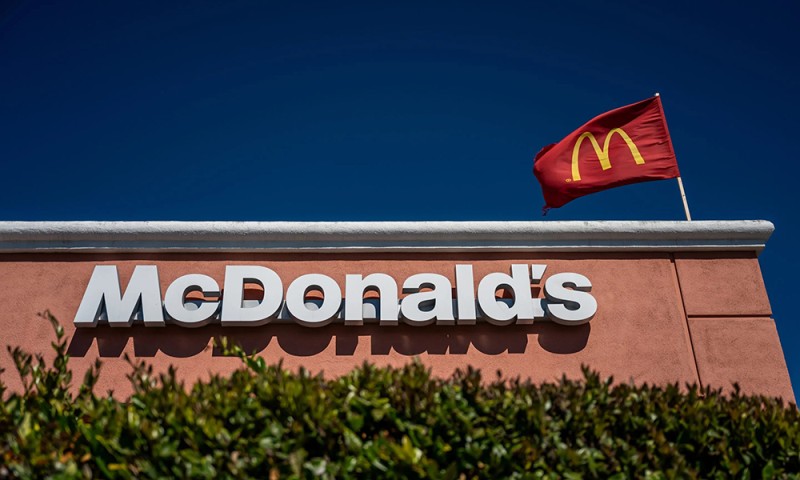
麦当劳正借助其汉堡和薯条的销售情况来反映美国经济的更大趋势。首席执行官克里斯·肯普钦斯基(Chris Kempczinski)正通过下调超值套餐价格来应对他所称的“双层经济”——即一部分消费者仍在随心所欲地消费,另一部分则开始收紧开支的分化局面。
自2022年通胀潮以来,麦当劳及其快餐竞争对手的套餐价格纷纷突破两位数,因此,多年来他们不得不面对消费者因菜单价格上涨而产生的不满情绪。高收入群体仍保持着对高端产品的消费热情,并且外卖使用频率保持高水平。但首席执行官肯普钦斯基在接受CNBC《Squawk Box》采访时指出,低收入消费者正在收紧开支,快餐对他们而言已不再是日常必需品,而更多成为偶尔消费。他对主持人透露,麦当劳过去一年多来一直在推进“超值套餐之旅”。
“中低收入消费者尤其正在承受巨大压力,”肯普钦斯基对CNBC主持人说,“他们周围很多人在讨论‘经济状况如何,现在怎么样?’而我们看到的情况是,经济实际上正在形成一种双层结构。如果你是年收入超过10万美元的高收入群体,日子还算不错……但中低收入消费者的处境却截然不同。”他指出,麦当劳的中低收入群体客流量下降了两位数,他们要么不吃早餐,要么在家吃饭。
采访中,CNBC主持人还向肯普钦斯基抛出了若干政治话题,包括麦当劳是否契合美国卫生与公共服务部(HHS)部长罗伯特·F·肯尼迪提出的“让美国再次健康”(MAHA)的目标,以及他对小费免税政策的看法。肯普钦斯基表示,他个人支持小费免税,但同时表明这对麦当劳意义不大,因为麦当劳不允许收取小费。他补充说,允许收取小费的餐厅的最低时薪仅为2.13美元,该标准自1991年沿用至今,他称这种模式存在“不公平竞争”,因为你“既想让顾客为你的劳动力买单”,还想享受免税优惠。他呼吁为所有餐厅制定统一的联邦最低工资,并表示麦当劳对提高联邦最低工资持“开放”态度。他还透露,公司正就包括此问题在内的多项议题与白宫保持沟通。
美国现行联邦最低时薪为7.25美元,该标准自2009年7月24日实施后从未调整。这一标准已经逾16年未作调整,这是美国有史以来最低工资标准停滞时间最长的一次。然而,许多州和地方已实施更高的最低工资标准,如哥伦比亚特区最低时薪高达18美元。
2025年,一项名为《提高工资法案》(Raise the Wage Act)的重要新立法提交美国国会审议。该法案计划逐步提高联邦最低工资标准,到2030年达到每小时17美元,并逐步取消对有小费员工、残障员工和青年员工的次级最低工资标准。此外,参议院还提出一项法案,拟自法案通过后次年1月1日起将最低工资提高到每小时15美元。这些立法举措表明,在经历十余年停滞后,联邦层面终于出现了要提高最低工资的势头。
与大萧条时期不同
肯普钦斯基补充说,此轮情况与麦当劳在大萧条时期所经历的不同,“那时候消费者普遍降低消费档次”。因此,麦当劳现在必须采取更具创意的方式来吸引不同消费群体。公司现在推出了改良版5美元套餐,并在核心市场开展更多促销活动,让低收入消费者也能吃得起。广告宣传重点突出了“超值”主题,试图打动那些天天为省钱发愁的节俭家庭。
这一战略凸显了麦当劳的平衡之道。作为少数几家具备足够规模与采购优势、能在不立即重创盈利的前提下降价的全球连锁企业之一,麦当劳得以在小型竞争对手无法施展的地方发力。但在美国经营大部分门店的特许经营商仍心存顾虑,他们担心在工资、房租和保险成本高企的背景下,较低的定价可能会进一步压缩利润空间。尽管如此,肯普钦斯基在接受CNBC采访时仍表示,推行更多超值选择的做法在特许经营商中“几乎获得一致支持”,此结果令主持人颇感意外。
更广阔的零售图景
麦当劳的“双轨”战略反映了美国经济中普遍存在的分化趋势。沃尔玛(Walmart)、塔吉特(Target)等大型零售商也报告了类似情况。Dollar General首席执行官托德·瓦索斯(Todd Vasos)今年3月直言:“许多顾客表示他们的钱只够买基本生活必需品。”而作为富裕消费群体需求风向标的达美航空(Delta Air Lines),尽管因特朗普关税政策带来的不确定性而在2025年下调了业绩预期,但作为美国最赚钱的航空公司,其整体发展态势持续向好。
这种趋势让人联想起疫情期间形成的经济格局:“K型经济”。安永-博智隆(EY-Parthenon)首席经济学家格雷戈里·达科(Gregory Daco)在2023年对《财富》解释称,这意味着中低收入消费者就像“K”字形中向右下方延伸的一笔,走势向下;而高收入群体则持续向上。
麦当劳必须驾驭这种“K型”格局才能最大化消费者价值。这意味着既要守住其数十年来“平价餐首选”的地位,同时也要开拓更高利润机会,以安抚股东。这种平衡策略能否持续,很大程度上取决于美国这种双轨消费经济格局将延续多久。(*)
译者:刘进龙
审校:汪皓
麦当劳正借助其汉堡和薯条的销售情况来反映美国经济的更大趋势。首席执行官克里斯·肯普钦斯基(Chris Kempczinski)正通过下调超值套餐价格来应对他所称的“双层经济”——即一部分消费者仍在随心所欲地消费,另一部分则开始收紧开支的分化局面。
自2022年通胀潮以来,麦当劳及其快餐竞争对手的套餐价格纷纷突破两位数,因此,多年来他们不得不面对消费者因菜单价格上涨而产生的不满情绪。高收入群体仍保持着对高端产品的消费热情,并且外卖使用频率保持高水平。但首席执行官肯普钦斯基在接受CNBC《Squawk Box》采访时指出,低收入消费者正在收紧开支,快餐对他们而言已不再是日常必需品,而更多成为偶尔消费。他对主持人透露,麦当劳过去一年多来一直在推进“超值套餐之旅”。
“中低收入消费者尤其正在承受巨大压力,”肯普钦斯基对CNBC主持人说,“他们周围很多人在讨论‘经济状况如何,现在怎么样?’而我们看到的情况是,经济实际上正在形成一种双层结构。如果你是年收入超过10万美元的高收入群体,日子还算不错……但中低收入消费者的处境却截然不同。”他指出,麦当劳的中低收入群体客流量下降了两位数,他们要么不吃早餐,要么在家吃饭。
采访中,CNBC主持人还向肯普钦斯基抛出了若干政治话题,包括麦当劳是否契合美国卫生与公共服务部(HHS)部长罗伯特·F·肯尼迪提出的“让美国再次健康”(MAHA)的目标,以及他对小费免税政策的看法。肯普钦斯基表示,他个人支持小费免税,但同时表明这对麦当劳意义不大,因为麦当劳不允许收取小费。他补充说,允许收取小费的餐厅的最低时薪仅为2.13美元,该标准自1991年沿用至今,他称这种模式存在“不公平竞争”,因为你“既想让顾客为你的劳动力买单”,还想享受免税优惠。他呼吁为所有餐厅制定统一的联邦最低工资,并表示麦当劳对提高联邦最低工资持“开放”态度。他还透露,公司正就包括此问题在内的多项议题与白宫保持沟通。
美国现行联邦最低时薪为7.25美元,该标准自2009年7月24日实施后从未调整。这一标准已经逾16年未作调整,这是美国有史以来最低工资标准停滞时间最长的一次。然而,许多州和地方已实施更高的最低工资标准,如哥伦比亚特区最低时薪高达18美元。
2025年,一项名为《提高工资法案》(Raise the Wage Act)的重要新立法提交美国国会审议。该法案计划逐步提高联邦最低工资标准,到2030年达到每小时17美元,并逐步取消对有小费员工、残障员工和青年员工的次级最低工资标准。此外,参议院还提出一项法案,拟自法案通过后次年1月1日起将最低工资提高到每小时15美元。这些立法举措表明,在经历十余年停滞后,联邦层面终于出现了要提高最低工资的势头。
与大萧条时期不同
肯普钦斯基补充说,此轮情况与麦当劳在大萧条时期所经历的不同,“那时候消费者普遍降低消费档次”。因此,麦当劳现在必须采取更具创意的方式来吸引不同消费群体。公司现在推出了改良版5美元套餐,并在核心市场开展更多促销活动,让低收入消费者也能吃得起。广告宣传重点突出了“超值”主题,试图打动那些天天为省钱发愁的节俭家庭。
这一战略凸显了麦当劳的平衡之道。作为少数几家具备足够规模与采购优势、能在不立即重创盈利的前提下降价的全球连锁企业之一,麦当劳得以在小型竞争对手无法施展的地方发力。但在美国经营大部分门店的特许经营商仍心存顾虑,他们担心在工资、房租和保险成本高企的背景下,较低的定价可能会进一步压缩利润空间。尽管如此,肯普钦斯基在接受CNBC采访时仍表示,推行更多超值选择的做法在特许经营商中“几乎获得一致支持”,此结果令主持人颇感意外。
更广阔的零售图景
麦当劳的“双轨”战略反映了美国经济中普遍存在的分化趋势。沃尔玛(Walmart)、塔吉特(Target)等大型零售商也报告了类似情况。Dollar General首席执行官托德·瓦索斯(Todd Vasos)今年3月直言:“许多顾客表示他们的钱只够买基本生活必需品。”而作为富裕消费群体需求风向标的达美航空(Delta Air Lines),尽管因特朗普关税政策带来的不确定性而在2025年下调了业绩预期,但作为美国最赚钱的航空公司,其整体发展态势持续向好。
这种趋势让人联想起疫情期间形成的经济格局:“K型经济”。安永-博智隆(EY-Parthenon)首席经济学家格雷戈里·达科(Gregory Daco)在2023年对《财富》解释称,这意味着中低收入消费者就像“K”字形中向右下方延伸的一笔,走势向下;而高收入群体则持续向上。
麦当劳必须驾驭这种“K型”格局才能最大化消费者价值。这意味着既要守住其数十年来“平价餐首选”的地位,同时也要开拓更高利润机会,以安抚股东。这种平衡策略能否持续,很大程度上取决于美国这种双轨消费经济格局将延续多久。(*)
译者:刘进龙
审校:汪皓
McDonald’s is banking on burgers and fries to tell a bigger story about the American economy. Chief executive Chris Kempczinski is slimming down the cost of the fast-food giant’s value meals as he grapples with what he calls a “two-tier economy”—a widening divide between consumers who are still spending freely and those who are pulling back.
For years, dating back to the 2022 inflation wave, McDonald’s and its fast-food rivals have contended with shopper frustration over rising menu prices, with combo meals increasingly breaking into double digits. Customers at the higher end of the income spectrum continue to order premium products and use delivery apps at healthy rates. Lower-income diners, however, are cutting back, Kempczinski argued in an interview on CNBC’s Squawk Box, treating fast food less as a daily convenience and more as an occasional splurge. He told the anchors that McDonald’s has been on a “value journey” over the past year or so.
“Particularly with middle- and lower-income consumers, they’re feeling under a lot of pressure right now,” Kempczinski told the CNBC anchors. ”There’s a lot of commentary around, ‘What’s the state of the economy, how’s it doing right now?’ And what we see is, it’s really kind of a two-tier economy. If you’re upper-income, earning over $100,000, things are good … What we see with middle- and lower-income consumers, it’s actually a different story.” He cited traffic for these demographics being down double digits, and they’re skipping breakfast or eating at home.
Kempczinski was pressed on some political issues by the CNBC anchors, including whether McDonald’s fits in with HHS Secretary Robert F. Kennedy’s MAHA (Make America Healthy Again) goals, and the policy around no taxes on tips. Kempczinski said he personally supported the no taxes on tips policy, but clarified that it didn’t help McDonald’s much, as it doesn’t allow tips. A tips restaurant requires a minimum wage of just $2.13 per hour, he added, which hasn’t changed since 1991, calling this an “uneven playing field” as “you’re essentially getting the customer to pay for your labor,” plus the tax-free benefit. He called for one federal minimum wage for all kinds of restaurants, and then said McDonald’s was “open” to raising the federal minimum wage, adding that the company was “in dialogue” with the White House about several issues including this one.
The current federal minimum wage in the United States is $7.25 per hour, a rate that has gone unchanged since July 24, 2009. This long-standing rate has held for over 16 years, the longest period in U.S. history without an update to the minimum wage. However, many states and localities have adopted higher minimum wage rates, some reaching as high as $18 per hour, such as in the District of Columbia.
In 2025, significant new legislation called the Raise the Wage Act was introduced in Congress. This proposed law would incrementally increase the federal minimum wage to $17 per hour by the year 2030, phasing out subminimum wage rates for tipped workers, workers with disabilities, and youth workers. Additionally, a Senate bill was proposed to raise the minimum wage to $15 per hour starting Jan. 1 of the first year after its passage. These legislative efforts indicate momentum at the federal level to increase the minimum wage after more than a decade of stagnation.
Different from the Great Recession
Kempczinski added that this isn’t like what McDonald’s saw during the Great Recession, “when everyone traded down.” And so McDonald‘s has to be creative to play both sides of the issue. Increased accessibility for lower-income consumers now comes in the form of a revamped $5 meal bundle, along with more aggressive price promotions in flagship markets. Advertising campaigns are leaning heavily on the theme of value, a message designed to resonate with cost-conscious families forced to make sharper tradeoffs in their daily spending.
The strategy underscores a balancing act for McDonald’s. As one of the few global chains with the size and procurement power to cut prices without immediately crippling profitability, the company can play offense where smaller rivals cannot. Still, franchisees—who operate most U.S. locations—are wary that thinner price points could turn into margin squeezes just as wages, rent, and insurance remain high. Still, Kempczinski told the CNBC anchors that the move toward more value was “almost unanimous” among franchisees, to a surprised reaction.
The broader retail picture
McDonald’s dual-track strategy echoes a broader split visible across much of the U.S. economy. Big-box retailers like Walmart and Target report a similar trend that Dollar General CEO Todd Vasos put his finger on in March: “Many of our customers report that they only have enough money for basic essentials.” Delta Air Lines, a proxy for demand among the affluent consumer cohort, has largely gone from strength to strength as America’s most profitable airline, although it has lowered guidance during 2025, owing to uncertainty from the Trump tariff regime.
The trends recall an economic pattern established during the pandemic: the “K-shaped” economy. As Gregory Daco, chief economist at EY-Parthenon, explained to Fortune in 2023, this means that middle- and lower-income consumers are one leg of the “K,” pointing down and to the right, while the upper-income cohort is doing better and better.
McDonald’s, though, has to master the “K” to get the most out of its consumers. That means fighting to maintain its decades-old position as the go-to spot for an affordable meal, even as it courts higher-margin opportunities to keep shareholders satisfied. Whether that balancing act proves sustainable may depend on just how long America’s two-track consumer economy sticks around.

